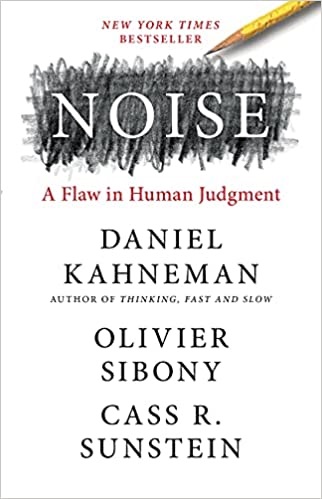
Noise: A Flaw in Human Judgement by Daniel Kahneman, Oliver Sibony, and Cass Sunstein details how noise and bias result in errors in judgment. From our courts to fields as diverse as medicine and insurance they show how noise leads to unfair and harmful results. They also provide ways to identify noise and techniques that any organization can use to reduce it. This book is a must for any professional development library. (10-15 minute read)
Introducion: Two Kinds of Error
- Whenever you look at human judgments, you are likely to find noise. From the courtroom to medicine to forecasts to forensics and personal decisions our lives are full of noise. This book will help you recognize it and give some tips for getting rid of at least some of it. Start with an analogy that features targets and groups of shooters to see the difference between noise and bias If shots are scattered all over the target, that’s noise. It the shot are all in the lower right, that’s bias.
Part I: Finding Noise
1. Crime and Noisy Punishment
- We start with the noise associated with crime and the sentencing of the guilty parties. In 1973, Marvin Frankel, a famous judge, realized that people committing the same crime were getting vastly different sentences depending on who the judge was. Judges gave harsher sentences when they were hungry and the day after their team lost. Blacks got harsher sentences and people are less likely to be granted asylum when it’s hot. The sentencing reform act of 1984 helped narrow the differences, but the Supreme Court struck it down in 2005 and discrepancies increased again. Female and Democrat judges are more lenient.
2. A Noisy System
- Here we encounter he basic tool called the noise audit that all organizations need to consider. Its essence is to have many people look at the same information and make independent judgments. The variance in these judgments will give you a sense of the magnitude of the noise in the system. The authors use the median difference from the mean in the audit as a measure of noise. Keep in mind that errors do not cancel out, they add up. In many cases, the person making a judgment might as well be chosen by lottery. It’s important not to confuse judgment with taste or opinion. It’s important to have people with different perspectives when you are trying to solve a problem.
3. Singular Decisions
- Singular decisions are those that don’t recur with any great frequency. Getting married or buying a house are examples. While they are not free from the factors that produce noise, the definition of noise does not apply and you can’t do a noise audit. Practices that reduce error for recurrent decisions should be just as effective when it comes to singular decisions.
DrDougGreen.com If you like the summary, buy the book





